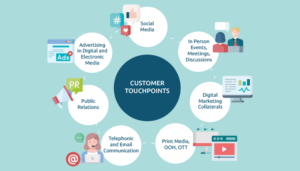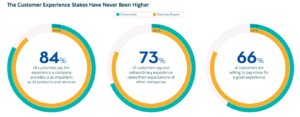Brand marketers and advertisers spend a lot of time coming up with unique campaigns, tactics, and processes while keeping prices low and assuring a solid return on investment (ROI). But the business dynamics keep changing continually, generating new trends in the market that businesses need to keep up with to stay in the market. Connected Customer Experience is one such trend in the Experience Economy which is making waves.
What is Connected Customer Experience?
The COVID pandemic has impacted everyone’s lives and lifestyles. People today are more connected than ever before, communicating with friends and family through various channels, and their interactions with businesses are no exception.
Connected Customer Experience includes your client’s experiences with your business and the whole customer journey, from initial contact to becoming a happy and loyal customer. To keep up with today’s fast-paced business environment, you’ll need to design connected user experiences that allow you to acquire real-time information that enables responsive and relevant experiences across all touch-points.

(Customer Touch-Points)
People interact with businesses via various devices and touch-points, from websites to apps. What is the challenge? To create a connected customer experience, companies must find a means to connect all of these diverse touch-points and combine several channels.
Building a connected customer experience is more complex than it appears, as it necessitates bringing together segregated consumer data, which is sometimes scattered over hundreds of systems.
Role of Data in the Economy
Data is critical for building unified consumer experiences in today’s business environment. To provide essential insights that shape the customer journey, firms must now be able to access and consolidate various sources of consumer data.
Many marketing leaders are gaining an advantage over their competitors by leveraging data and using it to develop new, imaginative ways to engage their target audiences. Top digital platforms are employing personalisation as a strategy to provide an exceptional experience to their audiences, resulting in a higher return on investment.
As a result, data is undoubtedly fueling today’s Experience Economy, and an innovation plan can assist you in thriving in the era of mass personalization.

(Customer Experience Statistics)
7 ways to create the connected customer experience
A defined roadmap around customer needs
The first step in developing a customer experience plan is to develop a clear customer-centric vision that you can share with your team. Companies combine previously segregated channel strategies to create unified marketing, advertising, commerce, and service strategies.
At the outset, a roadmap for product launches, marketing campaigns, and other initiatives can be established, taking into account top customer pain issues and technology and data. Make sure that this roadmap should be known by heart by every team member, and they should be incorporated into all aspects of training and development.
Identifying Your Customers and their Needs
Customers are important, but not all customers are created equal; some earn more revenue than others. The next step in putting these customer service standards into practice is to identify all the types of customers interacting with your web interface, customer service agent, or both.
You must first identify these clients and classify them into several groups before constructing your strategy around them. High spender, regular shopper, and high influencer are common segment splits, although these are ultimately unique to your organization. You can create great marketing campaigns and strengthen your marketing, commerce, sales, and service teams because they will have access to all of the data on the customers they are dealing with.
Creating a connection with Customers
When a team member establishes an emotional connection with a customer, the best customer experiences are achieved. According to a survey, a company that optimizes for emotional connection outperforms competitors in terms of sales growth by 85 per cent.
This is because word-of-mouth is no better way to develop your business organically. Happy clients are more likely to submit positive reviews or tell their friends about your service, which helps your company. Do you see how vital, connected user experience can be?
Make a Measurement Model
Because providing customer experiences necessitates a significant investment of time and money, it’s critical to demonstrate quick returns on investment through monitoring performance and effect.
Some ways to achieve that include:
- Auditing crucial touch-points in your customer journey framework to find measurement gaps is one approach.
- Standardizing data collecting naming conventions across channels
- Begin gathering relevant data as soon as possible so that you may utilize metrics to analyze the impact of your strategy and prioritize it.
- Using critical indicators to get information on consumer engagement and return on investment.
Unify your Data
Today’s businesses employ a variety of applications to store their data. Various teams in the same organization may utilize different applications at times. The only thing this accomplishes is to cause uncertainty among the teams. Missed opportunities to track client journeys can result from isolated data.
We now have the technology to integrate data across many platforms, allowing you to have all your business customer data in one place. Salesforce Customer 360 Data Manager is the name of the technology. Data unification is a daunting task; therefore, unify your data using a use case–driven method before establishing your customer data platform (CDP).
Invest in effective change management to ensure long-term success
Change management is generally the last item on a company’s mind regarding digital transformation, yet it’s the most important. Make time to train your teams on your ideal customer experience vision. By explicitly laying out your freshly generated roadmaps, show how they are vital in achieving that perfect experience.
Set up an input procedure for ongoing feedback on improving the experience once your teams have been aligned. Take client feedback seriously and keep your company accountable to avoid a disconnected customer experience.
Continuously test, evaluate, and optimize
Finally, use the metrics you’ve selected to track the progress of your customer journey and use cases to demonstrate success.
Ensure that technical teams have an efficient means to communicate outcomes back to the business so that the roadmap can be improved continuously. You will gain confidence in the data as a result of this collaboration.
Finally, have quarterly business reviews to bring together marketing, advertising, commerce, and service to examine the program’s results and adjust the roadmap based on the results.
Summing Up
Consumers today search for more than just transactions; they want to build relationships. Customers want a consistent, connected customer experience, which you can provide by encouraging API reuse. Are you interested in learning more about API Integration?
Don’t hesitate to get in touch with us right away.







